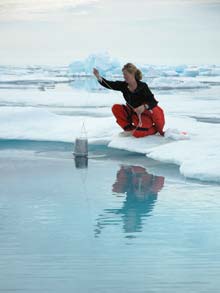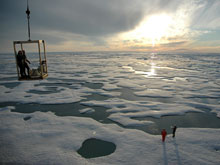
Mette Nielson lowers a baited amphipod trap into Arctic waters. The amphipods caught will be analyzed to determine where their food is coming from and what food items they eat. Click image for larger view.
Sea Ice for Dinner?
July 21, 2005
Mette Nielson
Sea-Ice Biologist
University of Alaska, Fairbanks
Sea ice is not a static substrate. It can break up and refreeze, and it can melt and disappear altogether, yet it plays an important role in ice-covered regions. When sea ice begins to form, growing ice crystals push the salt into pockets that get trapped in the ice. These are called brine channels and they create spaces in the ice where tiny plants and animals can live. Tiny, single-celled algae thrive in the bottom layers of the ice where they receive sunlight from above and nutrients from the water column below. Small, larval invertebrates colonize the ice to take advantage of this rich food source.
During melt periods the material drains down into the water column where it can be eaten by organisms below. The material can be an important food source for animals living below the ice in the water column and on the seafloor, but the amount of material that leaves the ice and is used by other animals is poorly understood. We are currently studying these relationships over deep basin waters using a variety of techniques, and will compare these findings to previous research conducted in Arctic waters.
Mette Nielson measures the temperature of a recently-drilled ice core. Variations in temperature at different points of the ice core (eg. top, middle, bottom) provide information about recent air temperatures in the region. Click image for larger view.
Scientists are lowered down onto Arctic ice in a "man lift". Sea-ice supports a variety of life and is integral to the Arctic Ocean's food web. Click image for larger view.
Since 2002, we have been looking into the role sea ice plays in the coastal Arctic food web by studying the diet of ice-associated amphipods in the shore waters of Barrow, Alaska. Amphipods are small crustaceans that feed on invertebrates and ice algae on the underside of the sea ice. They are a major food item for Arctic cod, serving as an important trophic link between ice-derived food and higher trophic levels, including seals and whales. The near-shore habitats we have been studying since 2002 harbor a lot of life in the sea-ice, water column and benthic realms; Life in these realms over the deep Canada-Basin, however, is less abundant.
Here, above the deep Canada Basin, we are using similar techniques to learn more about the offshore food web. We take ice cores to look at how much material is in the ice, and analyze how fast the ice algae are growing. We measure the temperature and salinity of the ice to gain information about the environment inside the ice where organisms are living, and use microscopic analysis to see the smallest members of the community. Like ongoing research we have been conducting in Barrow, we are collecting amphipods to look for specific biological markers in their tissue that tell us if they have been eating food produced in the ice or in the water column. We will also look in their stomachs to see what food items were last eaten. Using this information, we will try to estimate how much of their nutrition comes from the ice.
Knowing who eats what in the Arctic will contribute to our basic understanding of the ecology of this region, while determining how much food from the ice gets transferred to the organisms below will help us to understand what impact the declining ice cover might have on the Arctic community as a whole.
Sign up for the Ocean Explorer E-mail Update List.


































